Forbidden Mind
- Research material 心の力 研究資料
- 三つの心:意識、潜在意識、無意識
古代人と潜在意識 / Subconscious and ancients
古代人は潜在意識を活用していた
The ancients had utilizing subconscious
禁断のマインド / Forbidden Mind
意識を探る:再発見心の真の科学 - 古代の起源と最近のアプリケーションです
Exploring Consciousness: Re-Discovering the True Science of the Mind – It's Ancient Origins and Modern Applications
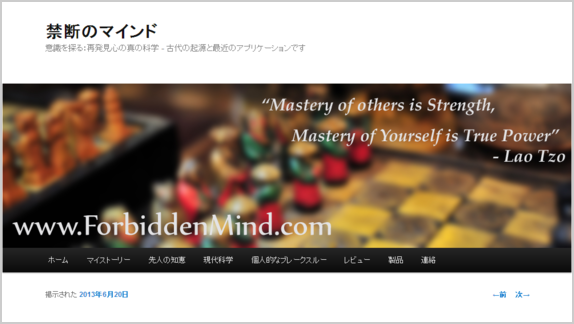
潜在意識と無意識のディベート(討論(会))は、最後に回答!
The Subconscious and Unconscious Debate Finally Answered!
これは、すべてがフロイトのせいです!
It's all Freuds fault!
言葉がお互いの代名詞であるかのように(彼の母親のための好奇心のフェチを含む)の学術混乱と活発な知的議論の世紀以上のすべてのために、ある特定の精神分析医は勘違いして、心理学の文献では同義的潜在意識と無意識の言葉を使い始めました。
Over a century of academic confusion and lively intellectual debate all because one particular psychoanalyst (with a curious fetish for his mother) misguidedly began using the words subconscious and unconscious interchangeably in psychological literature, as though the words were synonymous with each other
···しかし、それはケースであることを意味していませんでした! 何千年もの潜在意識と無意識の心は、極性の対向資質(夜と昼のような異なるなど)、心の陰と陽のコンポーネントで定義されていた。 まだフロイトと彼の遺産(そして上のほとんど百年)の後、ほとんどの学者や精神衛生の専門家を見て、その悲劇は、まだ理解されるべき任意の違いがある場合と思い、2項を両立させるのに苦労して。
…But that was never meant to be the case! For thousands of years the subconscious and unconscious mind were defined with polar opposing qualities (as different as night and day), the yin and yang components of the mind. Yet after Freud and his legacy (and almost a hundred years on), its tragic to see most academics and mental health practitioners still struggling to juggle the two terms, wondering if there's any difference to be understood.
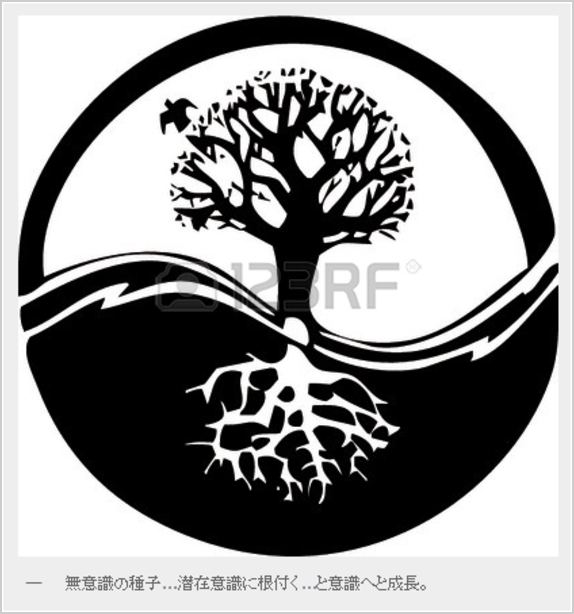
Seeds of the Unconscious…take Root in the Subconscious…And Grow into Consciousness.
マイケル·クレイグ·ミラー、MD、の上のシニアエディターHarvardsメンタルヘルスブログは潜在意識/無意識の議論の上の学術の不確実性ではなく、排他的に使用して、完全に彼らの学術文献から言葉「潜在意識」を否定することで、現代の医学雑誌に、取り組まれている方法を説明します私たちの心の深く隠された凹部に動作しているすべての私たちの「意識的以外の 'のプロセスを記述するために言葉「意識不明」。
Michael Craig Miller MD, the senior editor over at Harvards mental health blog describes how academic uncertainty over the unconscious/subconscious debate is being tackled, in modern medical journals, by completely negating the term 'subconscious' from their academic literature, instead exclusively using the word 'unconscious' to describe all our 'other than conscious' processes operating in the deep and hidden recesses of our minds.
彼はまた指摘し、なぜその彼らの目的は、効果的に影響を与えることがある場合、無意識の心の正確な定義を持っているメンタルヘルスの専門家のための極めて重要。
He also points out why its crucially important for mental health practitioners to have an accurate definition of the unconscious mind if their aim is to influence it effectively:
話を治す、「アナリストは、無意識を理解する方法は、多くの場合、彼または彼女が中心目的の一つ全うしようとする方法については、インストゥルメンタルである「「患者が意識不明に意識することによって救済を実現する手助けをすることです。 "
“ The way that an analyst understands the unconscious often is instrumental for how he or she tries to fulfill one of the central aims of the “talking cure,” which is to help a patient achieve relief by making the unconscious conscious.”
はっきりあなたが無意識の心を理解しかしまあ、彼が言うに言えば、あなたは精神医療従事者として作業している場合は、人々を治すことができるでしょうどのように効果的に正比例する。
Plainly speaking he says, however well you understand the Unconscious mind, is directly proportional to how effectively you'll be able to cure people if you're working as a mental health practitioner.
あなたがさびた刃であなたに心臓切開手術を行う資格のない医師に望んでいないだろう、あなたは廃れたモデル式の心彼の見当違いの言葉であなたに侵襲的な精神的な手術の実施に心理学者を望んでいないだろう。
You wouldn't want an unqualified doctor performing open heart surgery on you with a rusty blade, and you wouldn't want a psychologist with an OUTWORN model-of-the -mind performing invasive mental surgery on you with his misguided words.
まだアメリカは一人で、2011年に精神保健サービスに1130億ドルドルを費やしている。 それが問題にダイナミックな潜在意識/無意識のと「硬化」が患者しようとしているときに「話を治癒」内のフロントライン上のものは本当に良いよりも害をしているのかどうか私達の現在の理解の効果をもたらします。
Yet with America spending $113 billion dollars on mental health services in 2011 alone. It brings into question the effectiveness of our current understanding of the unconscious/subconscious dynamic and whether those on the front line within the “talking cures” are really doing more harm than good while attempting to “cure” their patients.
あなたが本当に(あなたは医療関係者や、あなたの人生に劇的な変化を作りたい誰かしているかどうか)、あなたは簡単にすべての問題を自己診断することができるでしょうし、潜在意識と無意識の心の違いを理解すれば真実があると本能的にあなたの挑戦から成長し、より明確に、より多くの権限を与え心は未来への移動から利益を得る力を与え、周囲にその状況を切り替える方法を知っている。
Truth is once you really understand the distinction between the subconscious and unconscious mind then (whether you're a health care practitioner or just someone who wants to make dramatic changes in your life), you'll easily be able to self-diagnose any issue and instinctively know how to switch that situation around, giving you the power to grow from your challenges and benefit from a clearer, more empowered mind moving into the future.
必要なのは、どんな苦しい挫折を経験して、何度も何度もの価値を引き出す続けることができ、金の新た機知に鍋にそれを変換できるようにすることのシステムです。
All you need is a system enabling you to experience any painful setback and transform that into a newly resourceful pot of gold you can continue drawing value from again and again.
大部分は、時間の被害とともに失わが心理的な錬 金術は、十分に古代世界に理解の練習だった。
Psychological alchemy was a practice well understood in the ancient world, although largely lost over the ravages of time.
無意識の今日のモデルは、我々は、馬(無意識)とライダー(幹部の心を)持っているということです。 ライダーがライダーへの最高の馬を支配し、それが彼のコマンドに従うことを得るために、それは別のに移動しようとしながら、馬は常に1方向に引っ張っている。
Today's model of the unconscious is that we have the horse (the unconscious mind) and the rider (the executive mind). The horse is always pulling in one direction while the rider wants it to move in another, its up to the rider to reign in the horse and get it to follow his commands.
私は、この近代的な理解を見つける問題は、内部闘争、軽度の統合失調症を意味する、それ自体に対するオフの意識を果たしているということで···2個性を調和させる場所でさまざまな欲望や別の本能(一匹、1人の)何も引っ張られ2。
The problem I find with this modern understanding is that it plays consciousness off against itself, implying an internal struggle, a mild schizophrenia…two personalities being pulled by different desires and different instincts (one animal, one human) and nothing in place to reconcile the two.
我々は信念を採用した場合でも、「馬がカートを引っ張る、我々だけで乗るために沿っている」...それはそう多くの人々が食料中毒や他の官能的な喜びの激しい禁断症状に苦しむ驚異である。
But if we adopt the belief “the horse pulls the cart, we're just along for the ride” …Is it any wonder so many people struggle with food addictions or intense cravings of other sensual pleasures.
私たちは私たちの内側の動物は私たち人間のより強力な一部であると信じる私たちの心の理由を与えると、それが私たちの生活や行動を制御するために、幹部の心をどのように制御できますでしょうか? 幹部の心は、それが喜ばとして馬は、一般的に行い、その制御ではなく、このモデルではと思うかもしれない...
When we give our minds reason to believe our inner animal is the more powerful part of our being, what control does that give the executive mind to control our life and behaviours? The executive mind might think its in control but in this model, the horse generally does as it pleases…
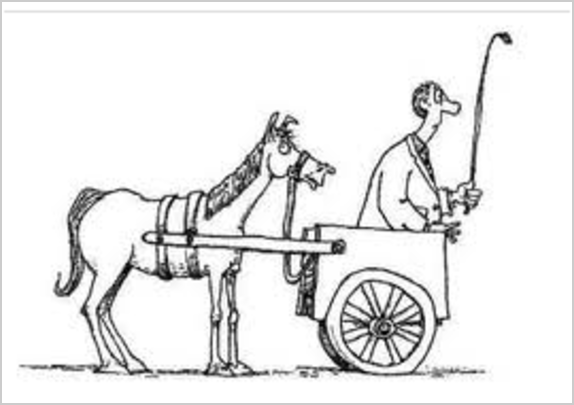
私たちの心は、信じられないほどの創造力を持っている!
Our minds possess incredible creative power!
我々は意識のこのバイポーラ機能を信じるように自分自身を調節した場合、私たちの心は、それらのものは、私たちにとって非常に現実的に見えるようにするのは非常に幸せであり、我々は人々は常に彼らの卑の欲望を征服するのに苦労する社会になってしまう。
If we condition ourselves to believe in this bi-polar function of consciousness, then our mind is quite happy to make those things seem very real for us, and we end up with a society in which people always struggle to conquer their baser desires.
あなたの欲望が道に迷ってあなたをリードしている場合は、それほど大きくない消費者の生産者、のために大きい。
Great for producers of consumerism, not so great if your desires are leading you astray.
我々の祖先は、私たちは心のこの二元的な性質を克服するために巧妙な心理的なシステムを思い付いた。
Our ancestors came up with an ingenious psychological system to help us overcome this dualistic nature of mind.
彼らは私たちの中に存在する極性を認識したが、むしろ獣に力を与えるよりも、彼らは意識の3次元を導入しました。 むしろ2に落ちるよりも、3本足で立っているテーブルスツールのように、彼らは、心理学者は、現在、今日使用しているものよりもはるかに安定性を持っていた心理的なシステムを開発しました。
They recognised a polarity existing within us, but rather than giving the beast the power, they introduced a third dimension of consciousness. And like a table stool that stands on 3 legs rather than falling on 2, they developed a psychological system that had much more stability than what psychologists are currently using today.
古代人は彼らのひどい潜在意識面(ベースレベルインパルスとエアコンの動作を表す部分)を認め、それらは意識の面とすべてを統合するための方法として、(彼らは神々の王、人間の合理的な学部として象徴される部分)を持っていた統一された全体的なシステムへの作品は、彼らが第三の側面を導入しました。
The ancients acknowledged their beastly subconscious aspect (the part that represented base level impulses and conditioned behaviour), they had the conscious mind aspect (the part they symbolised as king of the Gods, the rational faculties of man) and as a way to integrate all pieces into a unified holistic system they introduced the third aspect.
すべての意識的な理解を超え、既存の、神の心として知られるようになっている、洞察力やインスピレーションの点滅のその火花が、それらは稲妻のように象徴した。
Which became known as the divine mind, existing beyond all conscious understanding, its the spark of insight or flashes of inspiration they symbolised as lightning.
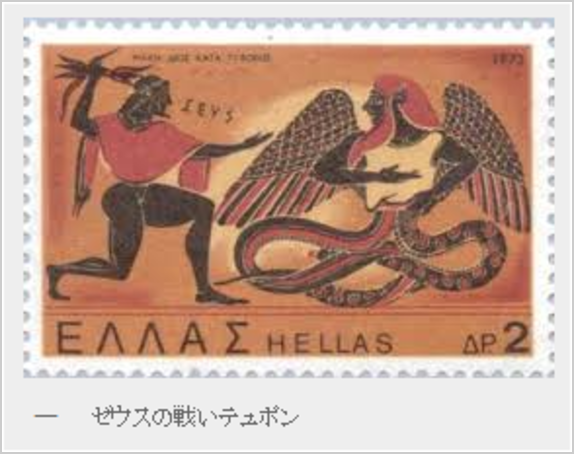
Zeus Battles Typhon
ジョセフ·キャンベルは、世界中の神話と宗教的な民話の比較研究を実施した最初の近代的な研究者だった。 彼はすぐにそのような話から出てくる三人組の原則に気づいた。 雷の神々に殺されている獣の物語。
Joseph Campbell was the first modern researcher to conduct a comparative study of all world Myths and religious folk tales. He quickly noticed a triadic principle emerging from such stories. Stories of a beast being slain by the Gods of lightning.
すぐにこれらの小さなスナップショットを見ている;
Quickly looking at a small snapshot of these;
・ギリシャではテュポンはエルメスの助けを借りてゼウスによって征服された戦いだった。
In Greek was the battle where Typhon was conquered by Zeus with the aid of Hermes.
・同じような戦いは、インドラ(心)、Vritra(獣)とアグニ(神の火)の間ヒンドゥー談合ヴェーダに見られる。
A similar battle is seen in the Hindu Rig Vedas between Indra (mind), Vritra (the beast) and Agni (divine fire).
・ドラゴンヨルムンガンドを征服トールの伝説。
The legend of Thor conquering the dragon Jormungand.
・また、[ジョブを誇るYHWH(ヤハ / ヤハウェ)によるリヴァイアサンの殺害に見る。
Also seen in the slaying of Leviathan by YHWH who then boasts to Job.
ジョセフ·キャンベルは人間の意識のダイナミクスを理解するための比喩的なアプローチとして、これらの神話を解釈します。 陰と陽の間でその戦い、混乱、暗闇の上の光の勝利...照明のプロセスに対する注文。
Joseph Campbell interprets these myths as the metaphorical approach to understanding the dynamics of human consciousness. Its the battle between yin and yang, order versus chaos, the victory of light over darkness…the process of illumination.
キリスト教では、このトライアドは、エジプトでは···父と子と聖霊の概念へとさらに進化し、そのイシス、ホルスとオシリス。
In Christianity this triad evolved further into the concept of the father, the son and the holy ghost…In Egypt its Isis, Horus and Osiris.
心理学的に言えば、意識潜在意識と無意識の違いを理解することは、本当に世界の主要な宗教を越え、そこに時間の経過とともに失われた心理的な錬金術の古代のコードを再利用見られる様々な三位一体の神話を囲む謎のロックを解除する極めて重要な鍵となります!
In psychological terms, understanding the difference between conscious, the subconscious and unconscious is really the pivotal key that unlocks the mysteries surrounding the various holy trinity myths found across the worlds major religions and therein reclaiming the ancient code of psychological alchemy that was lost over time!
そして今、この重要な基礎は、過去に使用されていた潜在意識と無意識の心の区別を説明し、彼らは心理的変化の古代錬金術のモデルにどのように適合するか示すために、その時間が導入されている。
And now this important groundwork has been introduced, its time to describe the distinctions between the subconscious and unconscious mind that were being used in the past and show how they fit into the ancient alchemical model of psychological change.
手がかりは、名前に既にある
The clue is already in the names
ほとんどの人は「潜在意識」のように接頭辞「サブ」を考えるとき、彼らはほとんどの場合、下に以下の意味を推測する。 彼らは(あなたは、深い奥などダウン深く深く、まだ...を行っている)の深さを参照し、共通の催眠暗示を生じることの意識下にあると潜在意識を参照してください。
When most people think of the prefix 'sub' as in 'subconscious' , they almost always infer the meaning of beneath or below. They see the subconscious as being beneath consciousness giving rise to common hypnotic suggestions referring to depth (you're going deeper, deeper and deeper still…all the way down etc.)
しかし、潜在意識の「サブ」は、実際に意識の「主観的な」側面を参照しています。 それは個人の内部の経験の中に全ての現象を指します。 ここまで意識の下にあることから、主観的な経験は、あらゆる角度や方向から意識を包含し、それは我々が解釈し、臨場感を作るのか、その常にあり、どんなに私たちがどのような方向に移動、私たちを取り囲んでいません。
But the 'sub' in subconscious is actually referring to the 'subjective' aspect of consciousness. It refers to all the phenomena within an individuals internal experience. Far from being beneath consciousness, subjective experience encompasses consciousness from all angles and directions, it surrounds us, no matter what direction we move, its always there, its how we interpret and make sense of reality.
意識が大幅に私たちの合理的な思考プロセスを照らすの意識である場合には、潜在意識を収集し、私達の全体の感覚神経系(または身体意識)を介して処理されます、すべての感覚データです。 潜在意識は、私たちの行動を駆動し、自発的かつ原始的衝動を引き起こし、意識の外で処理されますそのこの感覚データのため「獣」と呼ばれています。
If consciousness is largely the awareness that shines on our rational thought processes, the subconscious mind is all the sensory data that gets collected and processed through our entire sensory nervous system (or body consciousness). The subconscious is referred to as 'the beast' because its this sensory data that gets processed outside of awareness, causing the spontaneous and primal impulses that drive our behaviour.
逃げるように強力な本能を生産、私たちの感覚神経系は、対向車の危険を処理するだろう、と我々は考える時間を持っていた前に、穴居人の時代に、私たちは例えば近づいサーベル歯虎を合理化し、分析することがダメだったそれについて私たちの足は、すでに安全のために最寄りの洞窟に向かって全力疾走している。
In caveman times, it was no good for us to rationalise and analyse an approaching sabre-tooth tiger for example; our sensory nervous system would process the oncoming danger, produce a powerful gut instinct to flee, and before we've had time to think about it our feet are already sprinting towards the nearest cave for safety.
時にはそれが他の回は、それが非常に敏感になり、時にはそれが思考で失わなり、私たちの感情に宿る、完全なボディ意識の中では、意識(意識)のトーチは、私たちの体によって作成されたすべての主観的な現象の中でローミングして自由である五感の喜びと驚きの私達の外部環境と楽しみ。 まれに、それは同時に、物理的身体のすべての主観的な経験を認識していません。
Within our complete body consciousness, the torch of awareness (the conscious mind) is free to roam among all the subjective phenomena created by our bodies; sometimes it dwells in our emotions, sometimes it becomes lost in thoughts, other times it becomes highly attuned to our external environment and delights in the joys and wonder of the 5 senses. Rarely is it aware of all the subjective experiences of the physical body simultaneously.
そして、潜在意識は、私たちの内部の主観的な経験、純粋に主観的なものである要約すると、潜在意識は私たちと一人で私たちに固有のものです...いや2人は、これまで私たちは一緒に、まったく同じイベントを通過したとしても、正確に同じ方法で世界を体験。 我々はすべての異なるフィルタを持っていると我々は冒険を変え静物のすべてを体験するように異なる意味を添付してください。
In summary then, the subconscious is purely subjective, our internal subjective experience, the subconscious is what's unique to us and us alone…no two people ever experience the world in precisely the same way, even if we go through the exact same events together. We all have different filters and attach different meanings as we experience all of lifes varying adventures.
一方、意識不明 / The unconscious on the other hand
無意識の中の「UN」は 、必ずしも、それが意味するように'ではない'という意味ではありません。 意識不明の誰かのことを考えて、あなたは昏睡や緊張状態の路上で倒れ誰かにある人物の画像を得る可能性があります。 意識不明の意識消失を含みませんが、それはまた、さらに一歩行く。
The 'un' in unconscious doesn't necessarily mean 'not' as it implies. Thinking of someone who's unconscious, you might get an image of a person in a coma or someone who's collapsed on the street in a catatonic state. And although the unconscious does include the loss of consciousness, it also goes one step further.
無意識の中の「国連」のための... ユニバーサル意識短い。
The 'un' in unconscious is short for… Universal consciousness .
自然の入念な調査を経て、ピタゴラス、フィボナッチ、レオナルド·ダ·ヴィンチのような哲学者は、すべての生き物の間で共有ユニバーサルパターンに気づいた、一般的にフィボナッチの配列としても知られている、たとえば円周率の比は、発見された1ユニバーサルパターンだった。
Through the careful study of nature, Philosophers like Pythagoras, Fibonacci, Leonardo Da Vinci noticed universal patterns shared among all living creatures, the ratios of Pi for example,commonly known as Fibonacci's sequence was one such universal pattern discovered.
人体の比率を測定することと、前腕の長さに比べ手の長さは、完全な腕の長さに再び比べて、測定値は人体を繰り返し見られている円周率の関係を明らかにした。 この関係はまた、数学において、アーキテクチャでは、天文学では、植物が成長する方法で発見された···すべてのものに。
Measuring the ratios of the human body; the length of the hand compared to the length of the forearm, compared again to the length of the full arm; The measurements reveal a relationship of Pi that is seen repeatedly through the human body. This relationship was also discovered in how plants grow, in maths, in architecture, in astronomy…in everything.
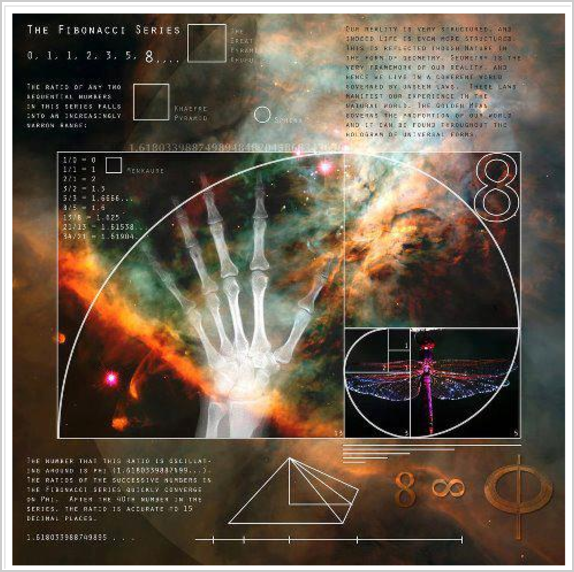
無意識のは経験的な世界を支配するこれらの原則、制御するために人間の意識を超えていますが、その私たちの物理的な世界への影響を慎重に観察して理解することができるものを指します。
The unconscious refers to those principles that govern the empirical world, that which is beyond human consciousness to control but can be understood through careful observation of its affects on our physical world.
無意識のはその後の神秘主義者は、神、すべてのものは何もが同時に存在する無限の可能性の分野の心としてそれを参照してください...私たちをアニメーション化し、すべてのレベルの作成全体の成長を引き起こす不思議な部分ということです。
The unconscious then is that mysterious part which animates us and causes growth across all levels creation…the mystics refer to it as the mind of God, the field of infinite potential where everything and nothing exists simultaneously.
心理学では無意識のより高い自己またはスーパー意識しという考えと同義である、それは我々の願望を見つけて、私たちの潜在的なに向けた洞察を得る場所です。 これは、進化やチャート運命のコースのためのフレームワークを提供します。 ユングはそれをシンクロニシティの分野では、「非因果的接続の原則」を造語。
In psychology the unconscious is synonymous with the idea of a higher-self or super-conscious, it's where we find our aspirations and gain insight towards our potential. It provides the framework for evolution and charts the course of our destiny. Jung coined it the field of synchronicity, the ”acausal connecting principle”.
だから、あなたがそれを持っている
''''So there you have it
最後に墓から持ち帰った無意識の区別VS潜在意識は、オフにまぶし、バックに人気の辞書に持ち込ま。
The subconscious vs unconscious distinctions finally brought back from the grave, dusted off and brought back into popular lexicon.
我々は彼らの個々の身体意識、彼らの感覚神経系、その基本的な本能、感情、肉体の欲望とどのように主観的に彼らの現実の意味を理解して作業している潜在意識の人と動作するように。
To work with a persons subconscious we're working with their individual body consciousness, their sensory nervous systems, their base instincts, emotions, carnal desires and how they subjectively make sense of their reality.
また、ユングは人の影と呼ばれるものの家だ。 シャドウ値(自己抑制側面は)私たちが賢明か照らさなるこれらの局面への意識の光を照射を通じて、人生を発生するすべての不運と悪いカルマを担当している。
It's also the home of what Jung referred to as a persons shadow. Shadow values (repressed aspects of self) are responsible for all the bad luck and bad karma we encounter through life, through shining the light of awareness into these aspects we become enlightened or illuminated.
意識不明で動作するようにすると、その後も彼らの充実性、創造性、情熱や願望にそれらを接続している間、人々が、自分の環境に戻って、自然で健康的なリズムに得るのを助けることです。 それはまだ活性化されていないか、認識されない可能性として志願が保持力と能力を指します。
To work with the unconscious then is to help people get back into a natural and healthy rhythm with their environment, while also connecting them to their fuller potential, their creativity, passions and aspirations. It refers to the powers and capacities aspirants hold in potentia that are as yet unactivated or unrecognised.
獣を飼いならすの神話は、古代の神話に、私たちの意識的な心は普遍的価値を識別するために学び、私たちの卑の本能と識別
The myth of taming the beast, in ancient mythology, is the process of our conscious minds learning to identify with universal values and overcoming the need to identify with our baser instincts.
我々は、特定の団体をドロップすると、私たちの主観的な自己はそれらの団体に基づいて行動する衝動を失う。 私たちはその場所にすることを選択しかし対応がより自由です。
Once we drop certain associations, our subjective self loses the impulse to act on those associations. We're more free to respond however we choose to in its place.
我々は普遍的価値で、より多くの識別などと、私たちは、私たちは生命、エネルギーと活力の源、リズミカルな雰囲気と大きな宇宙のパルスに叩くよりも大きく表示される場合が資質や行動を取る、我々はちょうどより多くのように見えるより多くのカリスマと影響力のある、完全な磁気、より多くの精神。
And as we identify more and more with universal values, we take on the qualities and behaviours that cause us to appear larger than life, a source of energy and vitality, tapping into the rhythmic vibe and pulse of the greater universe, we just seem more magnetic, more spirit full, more charismatic and influential.
思いやり、喜び、愛、平和、ブリス、創造...すべての資質の神秘主義は普遍的精神の性質であると認めます。 さらに我々は、より多くの我々は、これらの資質は、我々はなってより多くの精神的に伴う行動を採用し、それらの普遍的価値との意識を合わせます。
Compassion, Joy, Love, Peace, Bliss, Creativity…all qualities mystics acknowledge as being properties of the universal mind. The more we align consciousness with those universal values the more we adopt the behaviours which accompany those qualities, the more spiritual we become.
完成男はプライマル欲望のひどいプルダウンで動じない神の法則、至高の美徳と人格者、と整列1です。
The perfected man is one in alignment with Gods law, a man of supreme virtue and character, unfazed by the beastly pull of primal desires.
古代のミステリースクールでは、それらは意識以内に、このトライアドの各側面を習得するための3ステップバイステップのシステムを教えた。
In the ancient mystery schools they taught 3 step-by-step systems for mastering each aspect of this triad within conciousness.
あなたは完全に悟りを開いたと照射されてなることができますそれを通して処理します。 このものは、あまりにも長いがそのままになって以来、私は別のポストのためにその話を保存する必要がありますが、意識的な人格形成のプロセスは、後、部分的に(他の分野の中で)kaballaとして知られるようになりました!
Processes through which you can become a fully enlightened and illuminated being. This process of conscious personality development later became partly known as the kaballa (among other disciplines), although I'll have to save that story for another post since this ones getting far too long as it is!
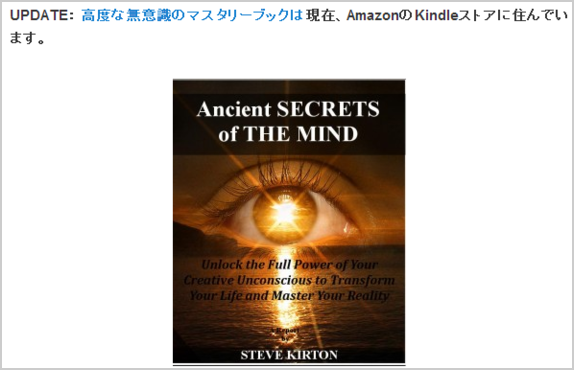
UPDATE: Advanced Unconscious Mastery eBook now Live on the Amazon Kindle store.
古く、心の科学は、非常に重要かつ秘密主義の研究の3分野、Essenian Kaballa、アレクサンドリアの神秘学や道教の錬金術の社会的エリートの複合側面の知恵の教えに分解された。
nciently, the science of the mind, was broken down into 3 areas of hugely important and secretive study, the wisdom teachings of the social elite combined aspects of Essenian Kaballa, Alexandrian Hermeticism and Taoist Alchemy.
電子書籍シリーズ「 心の古代人の秘密 」の第1巻は、アレクサンドリアのハーメチック哲学の概念を打ち破る、非常に詳細になり、それは歴史の中で使用され、応用されている方法を示しています。
Vol 1 of the ' Ancients Secrets of The Mind ' eBook series goes into great detail breaking down the concepts of the Alexandrian Hermetic philosophy and shows how it's been used and applied throughout history.
自分のイメージに社会のファブリックを成形するための電源の位置の人々によって悪用、あなた自身の欲望にあなたの個人的な現実を整形し、より大きな利益のためにこれらの概念を適用し、自分に有利な力のバランスを傾けるする方法を学びます。
Abused by people in positions of power to mould the fabric of society in their image, you'll learn how to apply these concepts for the greater good and tip the balance of power in your own favour, shaping your personal reality to your own desires.
あなたは、豊富に住んでいるあなたの創造的な天才を開発したり、単に無意識の心の深い本質的な理解を持っているかどうかそう。 下記の電子ブックは、あなたの最終的な成功への鍵を提供することに長い道のりを移動します。
So whether you want to live in abundance, develop your creative genius or just have a deep intrinsic understanding of the unconscious mind. The eBook below will go a long way in providing the keys to your ultimate success.
警告!5の潜在意識パワー4古代の秘密
Ancient Secrets to Subconscious Power 4 of 5
潜在意識との通信方法
HOW TO COMMUNICATE WITH THE SUBCONSCIOUS
マンダラの紹介
Mandala Introduction
http://thesevenworlds.wordpress.com/2014/06/05/mandala-introduction/
Asia, Buddhism, China Japan, Hinduism, India, Tibet June 5, 2014 Leave a comment
Thangka painting of Vajradhatu MandalaMandala
Mandala (Sanskrit: मण्डल Maṇḍala, ‘circle’) is a spiritual and ritual symbol in Hinduism and Buddhism, representing the Universe. The basic form of most mandalas is a square with four gates containing a circle with a center point. Each gate is in the general shape of a T. Mandalas often exhibit radial balance.
Mandala appears in the Rig Veda as the name of the sections of the work, but is also used in other Indian religions, particularly Buddhism.
In various spiritual traditions, mandalas may be employed for focusing attention of aspirants and adepts, as a spiritual teaching tool, for establishing a sacred space, and as an aid to meditation and trance induction.
In common use, mandala has become a generic term for any plan, chart or geometric pattern that represents the cosmos metaphysically or symbolically; a microcosm of the universe.
Religious meaning
A yantra is a two- or three-dimensional geometric composition used in sadhanas, or meditative rituals. It is thought to be the abode of the deity. Each yantra is unique and calls the deity into the presence of the practitioner through the elaborate symbolic geometric designs. According to one scholar, “Yantras function as revelatory symbols of cosmic truths and as instructional charts of the spiritual aspect of human experience”.
Many situate yantras as central focus points for Hindu tantric practice.Yantras are not representations, but are lived, experiential, non-dual realities. As Khanna describes:
Despite its cosmic meanings a yantra is a reality lived. Because of the relationship that exists in the Tantras between the outer world (the macrocosm) and man’s inner world (the microcosm), every symbol in a yantra is ambivalently resonant in inner–outer synthesis, and is associated with the subtle body and aspects of human consciousness.
Political meaning
The “Rajamandala” (or “Raja-mandala”; circle of states) was formulated by the Indian author Kautilya in his work on politics, the Arthashastra (written between 4th century BC and 2nd century AD). It describes circles of friendly and enemy states surrounding the king’s state.
In historical, social and political sense, the term “mandala” is also employed to denote traditional Southeast Asian political formations (such as federation of kingdoms or vassalized states). It was adopted by 20th century Western historians from ancient Indian political discourse as a means of avoiding the term ‘state’ in the conventional sense. Not only did Southeast Asian polities not conform to Chinese and European views of a territorially defined state with fixed borders and a bureaucratic apparatus, but they diverged considerably in the opposite direction: the polity was defined by its centre rather than its boundaries, and it could be composed of numerous other tributary polities without undergoing administrative integration. Empires such as Bagan, Ayutthaya, Champa, Khmer, Srivijaya and Majapahit are known as “mandala” in this sense.
Buddhism
Early and Theravada Buddhism
The mandala can be found in the form of the Stupa and in the Atanatiya Sutta in the Digha Nikaya, part of the Pali Canon. This text is frequently chanted.
Tibetan Vajrayana
In the Tibetan branch of Vajrayana Buddhism, mandalas have been developed into sandpainting. They are also a key part of Anuttarayoga Tantra meditation practices.
Visualisation of Vajrayana teachings
The mandala can be shown to represent in visual form the core essence of the Vajrayana teachings. The mind is “a microcosm representing various divine powers at work in the universe.” The mandala represents the nature of experience, and the intricacies of both the enlightened and confused mind.
While on the one hand, the mandala is regarded as a place separated and protected from the ever-changing and impure outer world of samsara, and is thus seen as a “Buddhafield” or a place of Nirvana and peace, the view of Vajrayana Buddhism sees the greatest protection from samsara being the power to see samsaric confusion as the “shadow” of purity (which then points towards it).
A mandala can also represent the entire universe, which is traditionally depicted with Mount Meru as the axis mundi in the center, surrounded by the continents.
Wisdom and impermanence
In the mandala, the outer circle of fire usually symbolises wisdom. The ring of eight charnel groundsrepresents the Buddhist exhortation to be always mindful of death, and the impermanence with which samsara is suffused: “such locations were utilized in order to confront and to realize the transient nature of life.” Described elsewhere: “within a flaming rainbow nimbus and encircled by a black ring of dorjes, the major outer ring depicts the eight great charnel grounds, to emphasize the dangerous nature of human life.” Inside these rings lie the walls of the mandala palace itself, specifically a place populated by deities and Buddhas.
The Five Dhyani Buddhas
One well-known type of mandala is the mandala of the “Five Buddhas”, archetypal Buddha forms embodying various aspects of enlightenment. Such Buddhas are depicted depending on the school of Buddhism, and even the specific purpose of the mandala. A common mandala of this type is that of the Five Wisdom Buddhas (a.k.a. Five Jinas), the Buddhas Vairocana, Aksobhya, Ratnasambhava, Amitabha and Amoghasiddhi. When paired with another mandala depicting the Five Wisdom Kings, this forms the Mandala of the Two Realms.
Practice
Mandalas are commonly used by tantric Buddhists as an aid to meditation.
The mandala is “a support for the meditating person”, something to be repeatedly contemplated to the point of saturation, such that the image of the mandala becomes fully internalised in even the minutest detail and can then be summoned and contemplated at will as a clear and vivid visualized image. With every mandala comes what Tucci calls “its associated liturgy [...] contained in texts known as tantras”, instructing practitioners on how the mandala should be drawn, built and visualised, and indicating the mantras to be recited during its ritual use.
By visualizing “pure lands”, one learns to understand experience itself as pure, and as the abode of enlightenment. The protection that we need, in this view, is from our own minds, as much as from external sources of confusion. In many tantric mandalas, this aspect of separation and protection from the outer samsaric world is depicted by “the four outer circles: the purifying fire of wisdom, the vajra circle, the circle with the eight tombs, the lotus circle.” The ring of vajras forms a connected fence-like arrangement running around the perimeter of the outer mandala circle.
As a meditation on impermanence (a central teaching of Buddhism), after days or weeks of creating the intricate pattern of a sand mandala, the sand is brushed together into a pile and spilled into a body of running water to spread the blessings of the mandala.
Kværne in his extended discussion of sahaja, discusses the relationship of sadhana interiority and exteriority in relation to mandala thus:
…external ritual and internal sadhana form an indistinguishable whole, and this unity finds its most pregnant expression in the form of the mandala, the sacred enclosure consisting of concentric squares and circles drawn on the ground and representing that adamant plane of being on which the aspirant to Buddha hood wishes to establish himself. The unfolding of the tantric ritual depends on the mandala; and where a material mandala is not employed, the adept proceeds to construct one mentally in the course of his meditation.”
Offerings
A “mandala offering” in Tibetan Buddhism is a symbolic offering of the entire universe. Every intricate detail of these mandalas is fixed in the tradition and has specific symbolic meanings, often on more than one level.
Whereas the above mandala represents the pure surroundings of a Buddha, this mandala represents the universe. This type of mandala is used for the mandala-offerings, during which one symbolically offers the universe to the Buddhas or to one’s teacher. Within Vajrayana practice, 100,000 of these mandala offerings (to create merit) can be part of the preliminary practices before a student even begins actual tantric practices. This mandala is generally structured according to the model of the universe as taught in a Buddhist classic text the Abhidharma-kośa, with Mount Meru at the centre, surrounded by the continents, oceans and mountains, etc.
Shingon Buddhism
The Japanese branch of Mahayana Buddhism — Shingon Buddhism—makes frequent use of mandalas in its rituals as well, though the actual mandalas differ. When Shingon’s founder, Kukai, returned from his training in China, he brought back two mandalas that became central to Shingon ritual: the Mandala of the Womb Realm and the Mandala of the Diamond Realm.
These two mandalas are engaged in the abhiseka initiation rituals for new Shingon students, more commonly known as the Kechien Kanjō (結縁灌頂). A common feature of this ritual is to blindfold the new initiate and to have them throw a flower upon either mandala. Where the flower lands assists in the determination of which tutelary deity the initiate should follow.
Sand mandalas, as found in Tibetan Buddhism, are not practiced in Shingon Buddhism.
Nichiren Buddhism
The Mandala in Nichiren Buddhism is called a moji-mandala (文字曼陀羅) and is a paper hanging scroll or wooden tablet whose inscription consists of Chinese characters and medieval-Sanskrit script representing elements of the Buddha’s enlightenment, protective Buddhist deities, and certain Buddhist concepts. Called the Gohonzon, it was originally inscribed by Nichiren, the founder of this branch of Japanese Buddhism, during the late 13th Century. The Gohonzon is the primary object of veneration in some Nichiren schools and the only one in others, which consider it to be the supreme object of worship as the embodiment of the supreme Dharma and Nichiren’s inner enlightenment.
The seven characters Nam Myoho Renge Kyo, considered to be the name of the supreme Dharma, as well as the invocation that believers chant, are written down the center of all Nichiren-sect Gohonzons, whose appearance may otherwise vary depending on the particular school and other factors.
Pure Land Buddhism
Mandalas have sometimes been used in Pure Land Buddhism to graphically represent Pure Lands, based on descriptions found in the Larger Sutra and the Contemplation Sutra. The most famous mandala in Japan is the Taima Mandala, dated to approximately 763 CE. The Taima Mandala is based upon the Contemplation Sutra, but other similar mandalas have been made subsequently. Unlike mandalas used in Vajrayana Buddhism, it is not used as an object of meditation or for esoteric ritual. Instead, it provides a visual representation of the Pure Land texts, and is used as a teaching aid.
Also in Jodo Shinshu Buddhism, Shinran and his descendant, Rennyo, sought a way to create easily accessible objects of reverence for the lower-classes of Japanese society. Shinran designed a mandala using a hanging scroll, and the words of the nembutsu (南無阿彌陀佛) written vertically. This style of mandala is still used by some Jodo Shinshu Buddhists in home altars, or butsudan.
Christianity
Forms which are evocative of mandalas are prevalent in Christianity: the celtic cross; the rosary; the halo; the aureole; oculi; the Crown of Thorns; rose windows; the Rosy Cross; and the dromenon on the floor of Chartres Cathedral. The dromenon represents a journey from the outer world to the inner sacred centre where the Divine is found.
Western psychological interpretations
According to art therapist and mental health counselor Susanne F. Fincher, we owe the re-introduction of mandalas into modern Western thought to Carl Jung, the Swiss psychoanalyst. In his pioneering exploration of the unconscious through his own art making, Jung observed the motif of the circle spontaneously appearing. The circle drawings reflected his inner state at that moment. Familiarity with the philosophical writings of India prompted Jung to adopt the word “mandala” to describe these circle drawings he and his patients made. In his autobiography “Memories, Dreams, Reflections,” Jung wrote:
“I sketched every morning in a notebook a small circular drawing,…which seemed to correspond to my inner situation at the time….Only gradually did I discover what the mandala really is:…the Self, the wholeness of the personality, which if all goes well is harmonious.” pp 195 – 196.
Jung recognized that the urge to make mandalas emerges during moments of intense personal growth. Their appearance indicates a profound re-balancing process is underway in the psyche. The result of the process is a more complex and better integrated personality. As Jungian analyst Marie Louise von Franz explains:
“The mandala serves a conservative purpose—namely, to restore a previously existing order. But it also serves the creative purpose of giving expression and form to something that does not yet exist, something new and unique…. The process is that of the ascending spiral, which grows upward while simultaneously returning again and again to the same point.
Creating mandalas helps stabilize, integrate, and re-order inner life.
According to the psychologist David Fontana, its symbolic nature can help one “to access progressively deeper levels of the unconscious, ultimately assisting the meditator to experience a mystical sense of oneness with the ultimate unity from which the cosmos in all its manifold forms arises.”
Source: https://en.wikipedia.org/wiki/Mandala
See also: http://www.arttherapyblog.com/